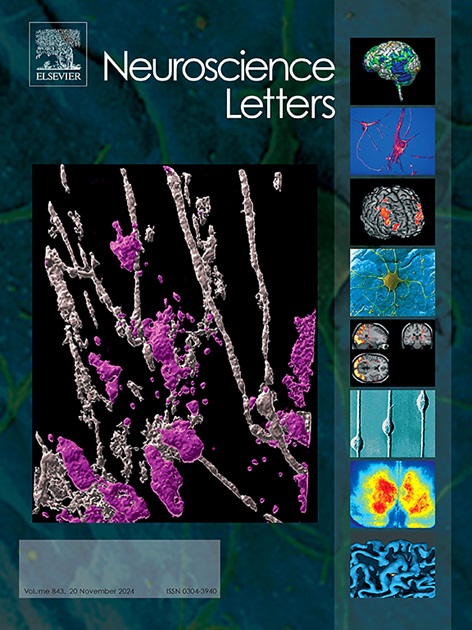Cocaine conditioning promotes persistent inhibition of GABAergic transmission in the mouse ventral hippocampal CA1 region
IF 2.5
4区 医学
Q3 NEUROSCIENCES
引用次数: 0
Abstract
Millions of individuals globally meet the current diagnostic criteria for cocaine use disorder (CUD), and cocaine misuse contributes to thousands of overdose deaths every year in the United States. Current hypotheses suggest that cocaine misuse imparts a diminished ability for synaptic plasticity (i.e., drug-induced metaplasticity). This metaplasticity impairs adaptive learning, which has been proposed to contribute to the likelihood of cocaine relapse. Delineating plasticity processes that mediate drug-seeking behavior can facilitate the development of therapeutic interventions for CUD. We used behavioral pharmacology and ex vivo patch-clamp electrophysiology to test the hypothesis that escalating cocaine doses elicit long-lasting, drug-seeking behavior that is correlated with a persisting decrease of GABAergic transmission in the mouse ventral hippocampus (vH) CA1 region. We found that noncontingent cocaine conditioning reduced the amplitude of evoked inhibitory postsynaptic currents measured from vH CA1 pyramidal cells 4–5 weeks after the last dose, suggesting sustained synaptic disinhibition. The magnitude of drug-seeking behavior observed 4 weeks, but not 1 day, after cocaine abstinence predicted the extent of synaptic disinhibition. Persisting inhibition of GABAergic transmission occurred in the absence of altered IPSC kinetics. We conclude that cocaine conditioning evokes a progressive metaplasticity that persistently shifts the GABAergic tone of the vH CA1 region, and these synaptic actions are correlated with long-lasting drug-seeking behavior in mice. Our results suggest that targeting metaplastic processes that modulate vH neuronal excitability represents a promising therapeutic strategy for relieving symptoms associated with CUD.

可卡因调节促进小鼠海马腹侧CA1区gaba能传递的持续抑制
全球有数百万人符合目前的可卡因使用障碍(CUD)诊断标准,而可卡因滥用导致美国每年有数千人因过量使用而死亡。目前的假设表明,可卡因滥用导致突触可塑性能力减弱(即药物诱导的元可塑性)。这种元可塑性损害了适应性学习,这被认为是导致可卡因复发的原因。描述调节药物寻找行为的可塑性过程可以促进CUD治疗干预措施的发展。我们使用行为药理学和离体膜片钳电生理学来验证这样一种假设,即不断增加的可卡因剂量会引发持久的药物寻求行为,这种行为与小鼠腹侧海马(vH) CA1区gaba能传递的持续减少有关。我们发现,非偶然可卡因条件作用在最后一次给药后4-5周降低了vH CA1锥体细胞诱发的抑制性突触后电流的振幅,表明持续的突触去抑制。在可卡因戒断后4周(而非1天)观察到的寻求药物行为的程度预测了突触去抑制的程度。在没有改变IPSC动力学的情况下,gaba能传递的持续抑制发生了。我们得出的结论是,可卡因条件作用引发了一种进行性的元可塑性,这种可塑性持续地改变了vH CA1区域的gaba能张力,这些突触行为与小鼠长期的药物寻求行为相关。我们的研究结果表明,靶向调节vH神经元兴奋性的化生过程是缓解CUD相关症状的一种有希望的治疗策略。
本文章由计算机程序翻译,如有差异,请以英文原文为准。
求助全文
约1分钟内获得全文
求助全文
来源期刊

Neuroscience Letters
医学-神经科学
CiteScore
5.20
自引率
0.00%
发文量
408
审稿时长
50 days
期刊介绍:
Neuroscience Letters is devoted to the rapid publication of short, high-quality papers of interest to the broad community of neuroscientists. Only papers which will make a significant addition to the literature in the field will be published. Papers in all areas of neuroscience - molecular, cellular, developmental, systems, behavioral and cognitive, as well as computational - will be considered for publication. Submission of laboratory investigations that shed light on disease mechanisms is encouraged. Special Issues, edited by Guest Editors to cover new and rapidly-moving areas, will include invited mini-reviews. Occasional mini-reviews in especially timely areas will be considered for publication, without invitation, outside of Special Issues; these un-solicited mini-reviews can be submitted without invitation but must be of very high quality. Clinical studies will also be published if they provide new information about organization or actions of the nervous system, or provide new insights into the neurobiology of disease. NSL does not publish case reports.
 求助内容:
求助内容: 应助结果提醒方式:
应助结果提醒方式:


